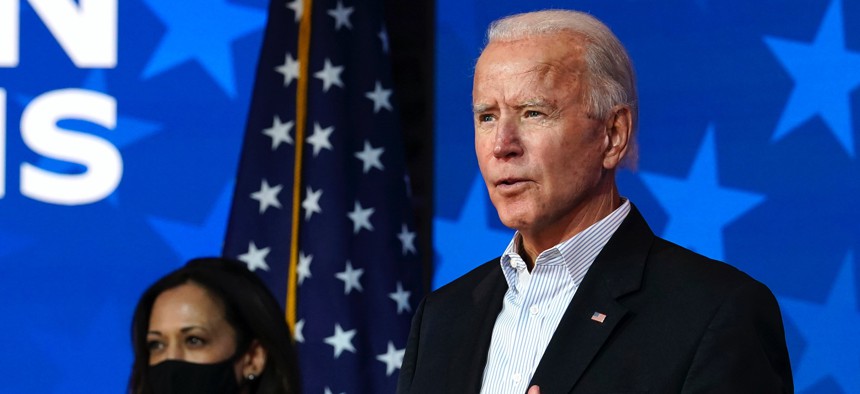
Democratic presidential candidate former Vice President Joe Biden speaks Thursday, Nov. 5, 2020, in Wilmington, Del. Democratic vice presidential candidate Sen. Kamala Harris, D-Calif., stands at left. AP / Carolyn Kaster
Biden Takes Lead In Pennsylvania; Win Would Decide Presidency
Many news outlets, including the Associated Press, have not yet made the call and Trump is not conceding.
After three long nights and two days of vote-counting in a handful of must-win battleground states, Democratic candidate Joe Biden pulled ahead of President Donald Trump in Pennsylvania — leading some news organizations to call the Keystone State and its 20 electoral votes for Biden.
A win in Pennsylvania would settle the race. But many news outlets, including the Associated Press, have not yet made the call. Some 130,000 ballots remain to be counted in the state, although most are from Democratic-leaning areas, including about 20,000 from the Philadelphia suburbs alone.
President Donald Trump is also contesting the state’s decision to accept mail-in ballots postmarked on or before Election Day for three days after the election. It’s one of several suits he has brought against state officials in battleground states, and the one that legal experts believe the courts are most likely to entertain, potentially prolonging the process. Many of the other suits have been thrown out.
“This election is not over,” the Trump campaign said in a statement after the Pennsylvania results were tallied Friday morning. “The false projection of Joe Biden as the winner is based on results in four states that are far from final.”
But if the call stands, it hands the presidency to Biden. So would a call in Nevada, where Biden leads by one point; or in Georgia, where Biden also took a razor-thin lead on Friday morning. (That margin — under .5 percent — has triggered a recount.)
Friday’s results appear to signal the beginning of the end of a painful and tumultuous week that glued Americans to their phones and televisions. Many of the worst-case scenarios that worried experts did not come to pass. There were isolated pockets of protests in cities across America — at least one of which, in Portland on Wednesday, led the governor to activate the National Guard. But there were no widespread clashes between protesters supporting opposite candidates, or between protesters and law enforcement.
In one incident in Pennsylvania on Friday morning, two armed men driving a Hummer truck with a QAnon sticker were arrested in an alleged plot to attack the Pennsylvania Convention Center where ballots are being counted.
In the short term, a Biden victory would cast the United States into what promises to be a tumultuous lame-duck period. Trump will remain commander-in-chief until Jan. 20, with a host of priorities in motion that were already on an accelerated timetable — including the ongoing U.S. withdrawal from Afghanistan. The mercurial incumbent was expected to dismiss multiple senior members of his national security team if he won, including Defense Secretary Mark Esper, and he may yet do so should Biden win. There are also questions about the mechanics of the handoff of power, with former officials raising concerns that the Trump officials might seek to lock in their own policies by withholding key information from the incoming administration.
And the spectre of unrest hangs over the coming months, as Trump continues to allege without evidence that he has been the victim of widespread fraud. Federal law enforcement and homeland security agencies are closely monitoring right-wing groups that have threatened violence — even civil war — leading up to or after the election.
“There’s simply no evidence anyone has shown me of any widespread corruption or fraud,” Sen. Pat Toomey, a Republican from Pennsylvania said Friday morning, calling Trump’s words “very disturbing.”
Should he take office, Biden has promised to repair vital international alliances critics say were damaged by Trump’s bellicose style, by rejoining international institutions and remaking a “coalition of democracies” abroad. Strained relations between the United States and key European allies that have become a feature of the Trump administration — under the spectre of a U.S. withdrawal from NATO — may return to some form of the pre-Trump status quo. Climate change will return to the agenda.
Biden may seek immediate reversals of some of Trump’s orders, like a controversial demand that the United States withdraw a significant number of its permanently-based forces from Germany — something defense leaders had said would take years to complete and now may not be completed at all. He has pledged to rejoin the Paris Climate Accords on day one and to reanimate President Barack Obama’s signature Iran nuclear deal, which Trump exited in 2018.
He is expected to elevate U.S. policy towards Central America, a region he worked on closely during the Obama administration, vowing to secure “concrete commitments from the leaders of El Salvador, Guatemala, and Honduras to take on the corruption, violence, and endemic poverty that drive migration.” The development of Trump’s signature border wall will become a thing of the past.
In some ways, Biden may continue with the Trump administration’s approach. The 2017 National Security Strategy, which prioritizes threats from Russia and China over the threat of terrorism, is expected to remain the broad frame for a Biden administration’s foreign policy.
And Biden would face many of the same key national security threats that have confronted Trump: a China that is increasingly muscular on the world stage. Ongoing Russian and Iranian provocations. The threat from ISIS and other Islamist terror groups still active in hotspots around the globe. The economic and public health fall-out from the COVID-19 pandemic.
Both candidates had called for the end of the so-called “forever wars,” with approaches that were almost identical when it came to Afghanistan: Pull out the majority of combat troops while preserving some counterterrorism capabilities through the undefined use of special operations forces.
But first, Biden must lodge an official victory in the presidential content. At least for now, that imprimatur remains outstanding.




